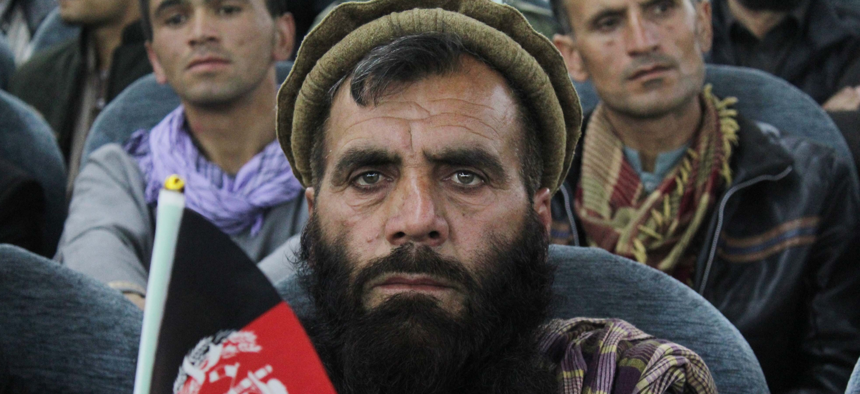
Afghan women, youths, activists and elders gather at a rally to support peace talks and the republic government in Kabul, Afghanistan, on March 29, 2021. Haroon Sabawoon/Anadolu Agency via Getty Images
It Was Never All or Nothing in Afghanistan
This is not something we hoped to see from national security leaders and a president we admire so much.
President Joe Biden’s decision to pull all troops from Afghanistan by September 11 unfortunately reveals that the commander in chief and his administration have accepted the false choice of two extremes — either complete withdrawal or an overgrown and debilitating military presence. While rhetorically simple, this kind of all-or-nothing thinking curtails a range of options available to the United States. It also diminishes our ability to pressure the Taliban at the negotiating table and assist the Afghan government with the ongoing security situation across the country. In short, it’s bad policy.
We served in Afghanistan starting over a decade ago, with the U.S. military, the NATO Senior Civilian Representative’s office, and the U.S. embassy in Kabul. We believe a stable Afghanistan is in the national security interests of the United States even if that commitment takes decades, but that this commitment is not one that requires, as in the past, an enormous military presence.
The “enduring commitment” NATO made during the transition from an international to an Afghan-led security mission was not designed only to underwrite the security of the Afghan nation through military assistance, but to support the development of institutions necessary to govern a nation fractured by decades of war. The strategies of that period, however, did not work as hoped. Initially, an insufficient number of Afghan security forces could operate independently. Judicial and local governance systems proved ineffective. Corruption ran rampant. And the economic system required a corrosive injection of tens of billions of dollars in foreign aid.
Still, the commitments and sacrifices of the international community, including 3,500 allied troops killed in action, have helped to put Afghanistan on a path to peace, even if long and arduous. It is this security commitment that has set the conditions that led to peace talks.
Today, Afghans conduct their own security operations; girls and boys learn in school; and citizens make their own democratic choices. Americans should be proud of all these advances, and especially the fact that Afghan life expectancy has risen dramatically along with every other health indicator.
The majority of foreign troops in Afghanistan today are not American. At the high-water mark in 2011, there were 100,000 U.S. troops in Afghanistan. Today, there are only 2,500. This is not the taxing military commitment that the White House argues prevents us from dealing with growing challenges in Europe or Asia. In fact, since December our allied partners had actually committed more troops, roughly 7,000. And today’s train-and-assist mission is not the combat one the U.S. had during the height of its military involvement a decade ago. We believe Biden’s withdrawal of the remaining U.S. and allied troops is premature and will likely impede the ability of the Afghan government to control their own territory from once again becoming a base for international terrorist attacks – one of the primary reasons for the invasion of 2001. While some overplay the immediacy of the threat posed by terrorist groups taking root in an ungoverned Afghanistan, an ungovernable Afghanistan is a haven for groups such as ISIS and al Qaeda.
Americans also must understand that an open ended military commitment, such as Afghanistan has become, does not mean a lack of progress towards peace. The parties are at the table and talking, something that seemed far-fetched a decade ago. Peace after a civil conflict is notoriously hard to finalize and often requires a generational shift of old hatreds. It’s also not unreasonable that a viable peace settlement will include an international military presence, or peacekeepers, to help guarantee security while the warring parties earn each other’s trust. The ability to preserve the peace, even in the face of acrimonious political disputes, similar to what has been seen in the Balkans and elsewhere is more desirable than falling back into war. U.S. and NATO forces still have a valid role to play.
Declaring an end to the war and invoking a symbolic September 11 deadline might seem satisfying, but the convenient and frankly cheap attempt to use it as a bookend for the attack on the United States 20 years ago suggests politics vice pragmatism are at play. Whether an attempt to placate the left wing of the Democratic party and the right wing’s isolationists and realists, unconditional withdrawal presupposes that this decision will end the war and the potential threat. This is not something we hoped to see from national security leaders and a president we admire so much. While we can certainly choose not to play, or play from just outside the borders, the war in Afghanistan will not end with a U.S. troop withdrawal. For us, this will once again be the shameful helicopter leaving in Saigon in 1975, and even if we could wash our hands, the Afghans will have to live with the real consequences.
Mark R. Jacobson is assistant dean, Washington programs, at Syracuse University’s Maxwell School of Citizenship and Public Affairs. He served in 2006 in Afghanistan as a naval intelligence officer and from 2009-2011 as the deputy political advisor, and then deputy NATO senior civilian representative.
Annie Pforzheimer is a non-resident senior associate at the Center for Strategic and International Studies. She is a retired senior Foreign Service officer who served in Afghanistan in 2009-2010, and again from 2017-2018 as deputy chief of mission, and as acting deputy assistant secretary of state for Afghanistan until March 2019.